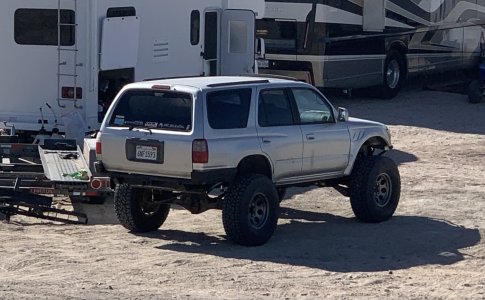KingJew_1902
Member
- Joined
- Feb 2, 2023
- Messages
- 22
Alright guys, need some pointers.
First shake down trip for my 99 4runner this past week for Thanksgiving after 2 years of piecing it together and actually finding time for the desert again.
The rig:
3.4 V6 rebuilt 13k miles ago (or 2yrs ago)
New radiator installed same time as eng rebuild
4wd
BTF +4.5 LT kit
Custom 4 linked rear end
4.88 gearing
Metric 35’s
Camped in Ocotillo Wells off Pole line Rd
Had fun running around in the hard pack but as soon as i get into the washes it would start to overheat after a few miles running it hard. I kept it in 4Hi, trying to keep up with a can am sxs and 4 dirtbikes.
I had some some issues with battery mount allowing the battery to shift, broke a ground wire. Noticed a rough idle so I checked plug boots. 3 werent fully seated. Fixed each of these issues. After the idle issue ai split from the group and hit the hwy back to camp.
After getting back to camp i found the air intake hose that connects directly to the throttle body wasnt fully seated. Fixed that hoping it was running lean and caused the overheating.
Next day all seemed well until I started hitting the sand washes again. Then a repeat of getting hot.
I was thinking maybe a larger radiator and electric fans could help but is there other things I should look at to alleviate the OH issue?

First shake down trip for my 99 4runner this past week for Thanksgiving after 2 years of piecing it together and actually finding time for the desert again.
The rig:
3.4 V6 rebuilt 13k miles ago (or 2yrs ago)
New radiator installed same time as eng rebuild
4wd
BTF +4.5 LT kit
Custom 4 linked rear end
4.88 gearing
Metric 35’s
Camped in Ocotillo Wells off Pole line Rd
Had fun running around in the hard pack but as soon as i get into the washes it would start to overheat after a few miles running it hard. I kept it in 4Hi, trying to keep up with a can am sxs and 4 dirtbikes.
I had some some issues with battery mount allowing the battery to shift, broke a ground wire. Noticed a rough idle so I checked plug boots. 3 werent fully seated. Fixed each of these issues. After the idle issue ai split from the group and hit the hwy back to camp.
After getting back to camp i found the air intake hose that connects directly to the throttle body wasnt fully seated. Fixed that hoping it was running lean and caused the overheating.
Next day all seemed well until I started hitting the sand washes again. Then a repeat of getting hot.
I was thinking maybe a larger radiator and electric fans could help but is there other things I should look at to alleviate the OH issue?


